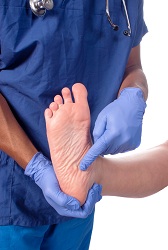Heel Pain

Heel Pain
It is estimated that 10% of Americans suffer from heel pain. The most common cause of heel pain is plantar fasciitis and ranks #3 on the list of most common running-related injuries. This is what led Groucho Marx to remark, “Time wounds all heels.” Fortunately, effective treatments for heel pain are available and 85% of patients can improve without surgery.
The Plantar Fascia
The arch is supported by muscles, tendons, ligaments, and a structure called the plantar fascia. This fascia is a very strong, ligament-like structure that attaches to the bottom of the heel bone and spans out to the bottom of the toe joints. It does not stretch when placed under tension. The fascia is only capable of stretching 4-5% before it begins to tear. With every step we take, the plantar fascia is placed under tension on average anywhere from 5,000 to 10,000 times every day.
Plantar Fasciitis
The most common cause of heel pain is inflammation of the plantar fascia, or plantar fasciitis. This inflammation causes pain in the fascia, heel bone, adjacent muscles and nerves. This is primarily an overuse injury associated with increases in activity, shoes, or body weight. In addition, sudden strains or injuries of the arch or heel can lead to fasciitis. In some cases, compensation for another foot or leg pain can cause overuse of the plantar fascia.
Typically, plantar fasciitis is painful with the first steps after resting, including getting out of bed in the morning. This occurs because the muscles in the feet and leg have been relaxed during rest. Pain then occurs when the fascia is placed under sudden tension after these periods of rest or inactivity. The pain will improve after walking because the muscles “loosen up.” However, the pain will often return and worsen the longer we are on our feet.
Plantar Fasciosis
A related problem to fasciitis is a condition called fasciosis. This problem can begin in as short as four weeks after the onset of heel pain. The difference between fasciitis and fasciosis is the whether the plantar fascia is normal in thickness and texture. Fasciitis is an acute inflammatory problem, whereas fasciosis is a chronic (longer duration) problem that involves small tears, scarring, thickening, and damage to the fascia. In some cases, both fasciitis and fasciosis are present at the same time.
Treatment
Treatment for plantar fasciitis is based upon two primary goals: reduce inflammation, reduce the strain in the fascia. Treatment typically includes: ice massage, roller massage, anti-inflammatory medication, cortisone injections, calf and arch stretches, arch supports, good shoes, heel pads, physical therapy, taping, night splints, or finally surgery. Generally, surgery is considered after three months or more of failed conservative treatment. The surgeries are outpatient and recovery takes six to twelve weeks.
This information is not intended to diagnose, treat, or prevent any injury or disease. It is intended to serve as an overview of running-related injuries and should not be used as a substitute for sound medical advice from a doctor or therapist.


